Transmembrane voltage-gated nanopores controlled by electrically tunable in-pore chemistry
- PMID: 39910030
- PMCID: PMC11799347
- DOI: 10.1038/s41467-025-56052-0
Transmembrane voltage-gated nanopores controlled by electrically tunable in-pore chemistry
Abstract
Gating is a fundamental process in ion channels configured to open and close in response to specific stimuli such as voltage across cell membranes thereby enabling the excitability of neurons. Here we report on voltage-gated solid-state nanopores by electrically tunable chemical reactions. We demonstrate repetitive precipitation and dissolution of metal phosphates in a pore through manipulations of cation flow by transmembrane voltage. Under negative voltages, precipitates grow to reduce ionic current by occluding the nanopore, while inverting the voltage polarity dissolves the phosphate compounds reopening the pore to ionic flux. Reversible actuation of these physicochemical processes creates a nanofluidic diode of rectification ratio exceeding 40000. The dynamic nature of the in-pore reactions also facilitates a memristor of sub-nanowatt power consumption. Leveraging chemical degrees of freedom, the present method may be useful for creating iontronic circuits of tunable characteristics toward neuromorphic systems.
© 2025. The Author(s).
Conflict of interest statement
Competing interests: The authors declare no competing interests.
Figures
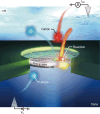
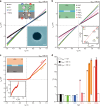

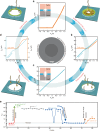
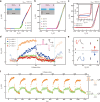
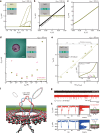
Similar articles
-
Asymmetric ion transport through ion-channel-mimetic solid-state nanopores.Acc Chem Res. 2013 Dec 17;46(12):2834-46. doi: 10.1021/ar400024p. Epub 2013 May 28. Acc Chem Res. 2013. PMID: 23713693 Review.
-
Voltage-Rectified Current and Fluid Flow in Conical Nanopores.Acc Chem Res. 2016 Nov 15;49(11):2605-2613. doi: 10.1021/acs.accounts.6b00395. Epub 2016 Sep 30. Acc Chem Res. 2016. PMID: 27689816
-
Redox-Driven Reversible Gating of Solid-State Nanochannels.ACS Appl Mater Interfaces. 2019 Aug 21;11(33):30001-30009. doi: 10.1021/acsami.9b05961. Epub 2019 Aug 6. ACS Appl Mater Interfaces. 2019. PMID: 31335118
-
Tunable Nanopore Arrays as the Basis for Ionic Circuits.ACS Appl Mater Interfaces. 2020 Dec 16;12(50):56622-56631. doi: 10.1021/acsami.0c18574. Epub 2020 Dec 7. ACS Appl Mater Interfaces. 2020. PMID: 33283510
-
Emerging issues of connexin channels: biophysics fills the gap.Q Rev Biophys. 2001 Aug;34(3):325-472. doi: 10.1017/s0033583501003705. Q Rev Biophys. 2001. PMID: 11838236 Review.
References
-
- Wu, C., Xing, Z., Yang, S., Li, Z. & Zhou, W. Nanoreactors for photocatalysis. Coord. Chem. Rev.477, 214939 (2023).
-
- Swisher, J. H., Jibril, L., Petrosko, S. H. & Mirkin, C. A. Nanoreactors for particle synthesis. Nat. Rev. Mater.7, 428–448 (2022).
-
- Wood, M. & Zhang, B. Bipolar electrochemical method for dynamic in situ control of single metal nanowire growth. ACS Nano9, 2454–2464 (2015). - PubMed
Grants and funding
LinkOut - more resources
Full Text Sources

